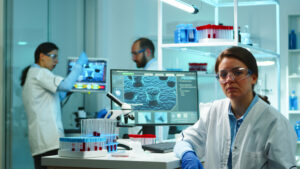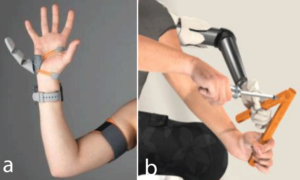From Motor Augmentation to Body Enhancement: Achieving Harmony Between the Human Body and Artificial Components
From Motor Augmentation to Body Enhancement: Exploring the Harmony Between Human Body and Artificial Parts
Introduction
The integration of artificial components with the human body has become a crucial frontier in biomedical engineering. What once seemed like a concept belonging to science fiction has now become an ongoing reality. The growth of motor augmentation and body enhancement technologies within biomedical engineering has opened up new avenues for improving human physical and cognitive abilities. This blog explores how motor augmentation technologies, like the Third Thumb, developed at the University of Cambridge, are reshaping the way we think about body limitations and body enhancement. It also highlights the role biomedical engineering plays in merging the human body with artificial components for enhanced capabilities.
The concept of biomedical engineering as a discipline has expanded far beyond traditional healthcare and prosthetics to include technologies that aim to improve human performance. The Third Thumb, for example, is a device that adds additional functional capabilities to the human body by giving the wearer an extra thumb. This case study and other examples of body enhancement serve as a prime example of biomedical engineering‘s role in advancing human capabilities.
The Science of Motor Augmentation in Biomedical Engineering

Motor augmentation, at its core, refers to enhancing the natural motor abilities of the human body by integrating artificial parts to extend the body’s range of motion, dexterity, and grasping abilities. This can involve anything from prosthetic limbs to more intricate technologies like robotic exoskeletons and even devices like the Third Thumb. The basic goal of motor augmentation is to enhance the body’s physical movements or abilities, sometimes by using devices that integrate seamlessly with the human body.
In biomedical engineering, the development of such technologies is rooted in biofeedback and wearable technology that utilizes various sensors and actuators to mimic or enhance biological functions. As an example, the Third Thumb works by using pressure sensors on the user’s foot to control the movements of the thumb, giving users the ability to perform tasks that would otherwise require an extra hand. This integration of wearable technology with the human body is a direct application of biomedical engineering.
Body Enhancement Through Biomedical Engineering
Body enhancement technologies aim to go beyond repair and restoration, offering the potential to enhance physical and cognitive functions that would not be possible naturally. The Third Thumb is a perfect example of biomedical engineering pushing the boundaries of what the human body can do by adding extra degrees of freedom (DoFs) to the body.
These supernumerary degrees of freedom (sDoFs) allow users to perform more complex movements, such as holding multiple objects at once or performing detailed manipulation tasks. In biomedical engineering, the focus has been on how these devices can either augment existing body parts or replace those that are lost due to injury or disease. For instance, prosthetic limbs, once limited to just basic functionality, have now evolved into advanced robotic arms and exoskeletons, controlled by neural interfaces that allow users to control them with their thoughts.
In the case of the Third Thumb, this kind of biomedical engineering innovation shows how human capabilities can be expanded beyond the usual two-handed functionality, enabling greater precision and flexibility in daily activities. Devices like this can have applications in industries requiring fine motor skills or in tasks where the ability to handle multiple objects at once is crucial.
The Role of Biomedical Engineering in Enhancing Human Dexterity
As biomedical engineering continues to evolve, researchers and engineers are constantly seeking ways to improve human dexterity. One significant advancement in this area is the development of robotic prosthetics and exoskeletons that assist with mobility, especially in individuals with disabilities. But beyond rehabilitation, biomedical engineering has turned its focus to enhancement—making a fully functional body even more capable. The development of wearable technologies like the Third Thumb aims to go even further than simple rehabilitation and restoration; it aims to improve what the human body can already do.
One of the main challenges of motor augmentation is ensuring the device integrates seamlessly with the user’s biomechanics. Biomedical engineering has addressed this challenge through the use of advanced sensor technologies, feedback loops, and actuators that allow artificial parts to function naturally with the human body’s movements.
For instance, devices like wearable robotic arms are engineered to interact with the body’s natural motions, allowing the user to manipulate objects more easily or even enhance their strength or dexterity. These advancements in biomedical engineering make tasks like lifting heavy objects, reaching for items, or performing detailed surgical procedures much more accessible and efficient.
Challenges in Biomedical Engineering for Body Enhancement
While the potential for body enhancement is immense, several challenges must be addressed. Biomedical engineering technologies like prosthetics and wearable enhancements must not only be functional but also safe and comfortable for the user. Some challenges that need further exploration include:
User Integration: The biggest challenge with motor augmentation devices is ensuring they integrate well with the user’s natural movements. Devices that add extra functionality to the body must not disrupt the body’s natural movement patterns. As technologies become more advanced, biomedical engineering solutions must ensure that devices like the Third Thumb feel like a natural extension of the body.
Long-Term Use and Comfort: Devices that enhance the human body must be designed for long-term use. Biocompatibility, weight, and comfort are essential factors in ensuring that the user can wear the device for extended periods without discomfort or fatigue. This requires the development of lightweight materials and ergonomic designs that integrate seamlessly with the human body.
Safety and Ethical Considerations: With the growing interest in body enhancement, ethical concerns are also coming to the forefront. Issues like privacy, consent, and access to these technologies need to be addressed. Furthermore, biomedical engineering solutions need to ensure that these devices do not harm the user and are safe for prolonged use.
Future of Body Enhancement Technologies
The future of body enhancement through biomedical engineering holds exciting possibilities. We are moving towards a future where wearable technologies seamlessly integrate with the human body, enhancing our abilities in ways that were previously thought impossible. Here are some possible advancements:
Advanced Prosthetics: Future prosthetics could allow for greater dexterity and flexibility, replicating the movements of a natural limb with precision.
Neural Interfaces: Research into neural interfaces is allowing for even more seamless integration between humans and machines. Future biomedical engineering solutions may include devices controlled entirely by the user’s thoughts, making them far more intuitive to use.
Cognitive Enhancement: As biomedical engineering evolves, there may also be advancements in cognitive enhancement, allowing for better memory, increased learning capabilities, and improved cognitive functions through wearable brain-computer interfaces.
Exoskeletons for Mobility: Exoskeletons that can assist with mobility and strength are already being used for rehabilitation and improving mobility for people with disabilities. In the future, these exoskeletons may become more advanced, assisting with tasks in everyday life or providing added strength for workers in physically demanding industries.
Conclusion
Biomedical engineering has opened new frontiers in motor augmentation and body enhancement. Technologies like the Third Thumb showcase the incredible potential of wearable devices in enhancing human capabilities. As we move forward, biomedical engineering will continue to innovate, pushing the boundaries of what is possible and offering solutions to enhance both physical and cognitive functions.
As we strive to overcome the challenges in user integration, comfort, and ethics, biomedical engineering will be at the heart of creating safer, more effective enhancements. From improving prosthetic limbs to developing robotic exoskeletons, the possibilities for body enhancement are endless. It is an exciting time for biomedical engineering, and the future holds incredible promise for human augmentation.

The third Thumb of Cambridge University Extra hand for assembly tasks. DoF augmentation concepts for motor augmentation.
What is motor augmentation in biomedical engineering?
A: Motor augmentation enhances human movement by adding extra degrees of freedom, like the Third Thumb, to improve functionality.How does the Third Thumb work?
A: The Third Thumb is controlled by pressure sensors under the foot, allowing users to perform tasks with increased dexterity.What are the challenges in body enhancement through biomedical engineering?
A: Challenges include user integration, comfort, long-term use, and addressing ethical concerns about accessibility and safety.How does biomedical engineering improve human mobility?
A: Exoskeletons and prosthetics developed through biomedical engineering assist with mobility and enhance physical strength for those with disabilities.What is the future of body enhancement in biomedical engineering?
A: The future includes neural interfaces, advanced prosthetics, and cognitive enhancement for improved human performance and capabilities.
